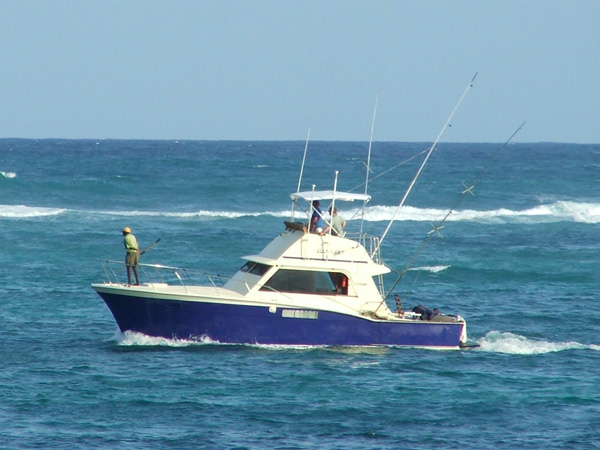
A fish blasts out of the water and inhales your topwater lure. You should be surprised and shell shocked but the truth is you were hoping something like this would happen. If these explosive strikes take place while fishing with a bait you have constructed by hand, the level of excitement increases dramatically. The memory of that first fish caught on a homemade topwater lure will remain with you forever, almost like remembering your first kiss. If this sounds exhilarating then I want to challenge you to make a topwater fishing lure. Experience the sense of accomplishment for yourself that this lure brings and build a memory that will last a lifetime.
The items needed for the making of this project are readily available. The budget for this lure is very small and you can get some materials free. With a working knowledge of hand tools you can easily make topwater lures that catch fish.
List Of Materials Needed For This Topwater Lure
1. You will need a discarded broom handle. This is for the body of the lure. If you do not have an old broom handle a 5/8" dowel can be a substitute.
2. Two large screw eyes are needed for this lure. One goes in the front of the lure and one for fastening the rear hook. The size is 1" overall length and .072" diameter. These have a closed eye and are made of stainless steel.
3. One small screw eye that is used to attach a treble hook to the middle of the lure. The size is 9/16" overall length and .050" diameter. This screw has a closed eye and is made of stainless steel too.
4. There are 2 split rings used to make this lure. Their purpose is to attach the hooks to the screw eyes. One is used with the middle screw eye. The other one is for the rear screw eye. Use a size 5 split ring.
5. Use a size 6 treble hook. Buy the best quality hooks you can afford. Keep in mind that your hook and line are the only connections between you and the fish. You would not want to lose a fish due to poor quality hooks.
6. A pair of round doll eyes approximately 1/4" diameter. I purchased these from a craft store.
7. Sanding Sealer is used to protect the wood from getting water logged. It also acts as a base coat.
8. You will need some paint for the lure. I use exterior latex because it is easier to clean up.
9. A strong bonding wood glue is used to affix the doll eyes to the fishing lure. This glue is used on the screw eyes also to ensure that they do not loosen.
10. Painters tape is used to get those sharp distinct lines between the different colors. This type of tape does not cause paint to chip or peel when it is removed.

Tool List For Constructing This Lure
1. A hand saw is used to cut the broom handle or dowel.
2. Needle nosed pliers are used for fastening the screw eyes to the lure body.
3. Split ring pliers are used to attach the split rings. These are attached to the screw eyes. Then the treble hooks are attached to the split rings.
4. Sandpaper is used to smooth the wood. Use at least 3 different grits starting with coarse and going to fine.
5. A paint brush is used for applying the paint.
Beginning The Construction
To begin constructing the topwater lure you first cut a 3 " long piece of wood from the broom handle. Start the sanding process with a heavy grit sandpaper and work your way down to a fine grit making sure to sand all the surfaces until they are very smooth.
Sealing The Lure
First wipe the 3" section of wood with a rag after you are finished sanding to remove all the dust left during the sanding process. Now you can insert one of the longer screw eyes 1/2 way down into the flat section of wood. Next dip the wood into the sanding sealer while holding the lure by the screw eye that you've just inserted. Hang the piece of wood for drying using a paper clip. After the wood is dry sand it using a very fine grit sandpaper and repeat this process 2 more times to ensure that the wood is properly sealed. Performing this process keeps the water from soaking into the wood which could cause damage to your lure.
Painting The Lure
You will now begin to apply paint your lure using a brush. When you are first learning how to paint a lure use a paint brush because it is easier. If you have experience using a spray can or an air brush you can certainly use either one of those methods too. Color schemes are important but in the beginning use either a red/white combination or solid black. When using the red/white combination make 1/3 of the lure red and 2/3 white. The red will be the head and the white will be the back of the lure. Begin by painting the entire lure white with no fewer than 3 coats. You will hang the lure to dry between coats of paint using the screw eye that was inserted before the sealing process.
Finishing Your Fishing Lure
When the paint is completely dry the other 2 screw eyes will be inserted into the fishing lure. By placing a small drop of wood glue on the shaft of each screw eye it will ensure that the screw eyes will not come loose. Remember that a long screw eye goes on each end of the lure and the short one is placed in the middle. Make the screw eye loops in the front, back and middle of the lure align with each other. The front hook of this lure was removed to help in showing how the alignment looks.

Next the doll eyes are glued to the front 1/3 of the fishing lure. The eyes should be parallel to each other. Place your doll eyes approximately 5/8" in from the front of the bait. Use a glue with a longer drying time instead of a 60 second glue. Why? Because this process takes time to get the eyes in proper alignment.
Now a clear latex finish is placed on the lure to help to keep the paint from chipping as well as further protecting the wood from getting water damage. Use at least 3 coats of the clear finish. Again use the screw eyes to hang the lure up to dry. The clear finish can be placed over the eyes too. Remember more thin coats of finish are always better than a few thick ones. Thin coats of the finish are more durable than thick coats.
Split rings are the next item added onto the fishing lure. Use the split ring pliers to easily accomplish this task. The split rings are placed onto the screw eyes in the middle and rear of the lure. After placing the split rings onto the screw eyes the hooks can be added. The split ring pliers are used to achieve this job too.

Now your D I Y topwater fishing lure is complete. My hope is that your first attempt at undertaking this project helps you to gain confidence in lure making. You can now go catch that once in a lifetime fish. If you don't catch the big one you will be elated with any size of fish. I can guarantee it will excite you when you catch that first fish, especially when it is on the lure you made. Buying lures is okay but making them is even better.

As you can see red beads were used for the eyes on this particular lure. Holes were drilled just deep enough for the beads to sit flush against the lure. This a good lure to use at night because of the black color. Notice too that there is a soda bottle cap glued to the front of the lure. This changes the design making the lure a popper style.
Anyone can make a topwater fishing lure. But only you can make one where it is said I did that myself.
LA Clippers outplay the star-filled Lakers

Good Equipped Fishing Charters for Fun


Copyright © www.mycheapnfljerseys.com Outdoor sports All Rights Reserved